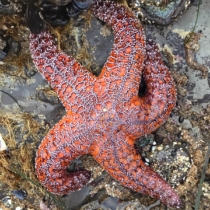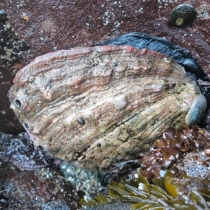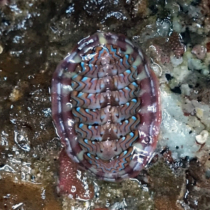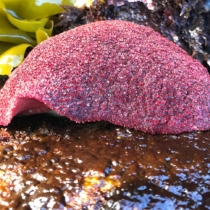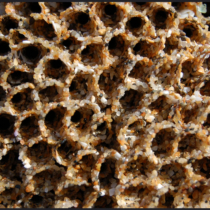
Filming at Fitzgerald
March 2015
LiMPETS is implementing student communication projects, like science blogging and filmmaking, aimed to take students beyond their monitoring experiences, deeper into the process of science. The goal is for teachers and students to think critically about their monitoring results and communicate the broader meaning of their work to a variety of audiences. Friends of Fitzgerald Marine Reserve provided LiMPETS with two GoPro cameras. A GoPro captures high-quality video, and in its waterproof housing, can withstand being dropped on the rocks, rolled in the sand, and pounded by waves. It’s durable, much like the tiny and tough intertidal denizens of Fitzgerald Marine Reserve.
Read more about the Friends of Fitzgerald Marine Reserve and LiMPETS partnership in the FFMR’s Newsletter.
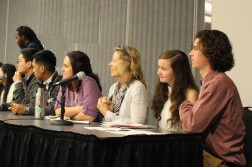
Strong Presence for LiMPETS at International Conference on Citizen Science
February 2015
Sanctuary and NOAA staff joined 600 people from 25 countries who convened February 11-12, 2015, at the San Jose Convention Center for “Citizen Science 2015,” the inaugural conference of the Citizen Science Association. LiMPETS staff and students participated in a variety of talks and panel sessions over the course of this two-day event.
LiMPETS presentations addressed engagement, research and evaluation of the student experience. ABC News covered the event, highlighting the joint LiMPETS panel session titled, “Diverse Perspectives on Youth-Based Citizen Science.” LiMPETS students from the Branson School, Lowell High School and the French-American School participated in the panel, and were interviewed by ABC news. Frankie Gerraty at The Branson School told ABC reporter David Louie, “It was incredible to have scientists coming up to us, asking questions about our research. They were all blown away by how we’re only in high school, and we have the opportunity to present at a prestigious conference.”

Students Present at Prestigious Scientific Conference
December 2014
LiMPETS students created scientific posters describing their long-term monitoring results and successfully presented their posters at the 2014 AGU (American Geophysical Union) conference.
The Branson School’s Sustainable Seas program created a poster on their Rocky Intertidal data collection at Duxberry Reef. California Academy of Sciences used the LiMPETS Sandy Beach program to train thier Careers In Science interns.

Origin of Sea Star Wasting Syndrome Identified
November 2014
Scientists solved the mystery of a disease that’s been killing millions of sea stars along the Pacific shores of North America. The pathogen responsible for the wide-spread sea star deaths is a virus called the “sea-star associated densovirus.”
To identify the source of the disease, scientists conducted DNA sequencing of viruses in tissue samples of sick and healthy sea stars. Then they tested the suspected viral culprit by injecting it into healthy sea stars in an aquarium. The injected sea stars died within 14 days. The densovirus does not cause the death, but weakens a sea star’s immune system. Susceptible to bacterial infections, a sea star can develop lesions, lose arms, and melt into gelatinous masses.
LiMPETS students, who monitor areas affected by sea star wasting disease, helped inform scientists at UC Santa Cruz to track the extent of the disease in California. The LiMPETS program will now, hopefully, begin to document the recovery of the California sea star population.

Retired teachers give students the opportunity to join LiMPETS
November 2014
The dream of a retired California State University, Stanislaus, biology professor to send every Turlock schoolchild to see the ocean and learn about sea life is at least partially coming true. Donations from retired educators will send 15 classes from five schools to Monterey this school year.
The kids see the Monterey Bay Aquarium’s floating jellyfish, deep-sea exhibits and touchable tidepool tables. In the second part of the trip, they head to the beach to count sand crabs as part of a scientific survey. Videos show kids digging sand and measuring the skittish little crabs with calipers between shrieks and laughs as tiny waves splash their ankles.
“It’s a really wonderful investment,” said retired Modesto Junior College professor Richard Anderson, who with wife Lynn Hansen helped start the field trips. With free admission from Monterey Bay Aquarium, free training and a beach science project through the nonprofit LiMPETS, and parent and community chaperones donating their time, Anderson figures he gets about $7,600 worth of bang for every 1,200 bucks he donates.
Donations to cover busing, the out-of-pocket cost of the trips, have come from friends of retired professor Pam Roe, who for years took her biology classes to Monterey for tide-pool monitoring.
“When Pam Roe retired from Stan State, she said she wanted to send every child in Turlock to the ocean,” Anderson said Friday. “I decided to help her make it happen.”
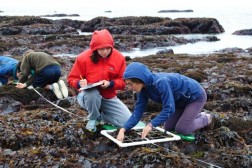
LiMPETS in Bay Nature
August 2014
By Sabine Bergmann | August 11, 2014
Presenting at the world’s largest geophysical sciences gathering has become a remarkable commonplace for high school students in a program called “LiMPETS” – Long-term Monitoring Program and Experiential Learning for Students – which was created in 2002 by the West Coast’s National Marine Sanctuaries as a way to harness the power of citizen science to monitor intertidal and sandy beach ecosystems.After 12 years of study the database contains more than 1,000 surveys with population figures for 34 different types of algae and invertebrates at 70 different monitoring sites. It has engaged more than 4,000 participants in the monitoring effort; 60 percent of them, like Rainsford, are in high school.
And it’s real data, says Dr. John Pearse, a professor emeritus of ecology and evolutionary biology at UC Santa Cruz and president of the Society for Integrative and Comparative Biology. The program has shown the destructive path of sea-star wasting disease and demonstrated positive effects of marine protected areas. Groups in Hawaii, Alaska and Peru have modeled initiatives after it.

Students give stellar presentations at research symposium
May 2014
High school students from James Logan High School, Santa Catalina High School, San Lorenzo Valley High School and the California Academy of Sciences presented research posters at the Monterey Bay National Marine Sanctuary Currents Symposium on Saturday, April 26th, 2014. The Currents Symposium is an annual event for researchers, educators, students, and the public to learn about current research being conducted in the Sanctuary. Student interns from the Academy of Science, Tiffany Cheng and Siyu Huang, won 2nd place for their LiMPETS poster on Acanthocephalan parasite loads in Pacific mole crabs. Congratulations to all of our LiMPETS students for their stellar posters and professionalism during the conference.

Sea Star Disease Update
February 2014
Sea star wasting syndrome has been spreading, causing mass mortality of stars along the west coast since Summer 2013. The disease is now affecting areas as far south as San Diego. In October 2013, LiMPETS students had documented the near disappearance of ochre sea stars at monitoring sites near San Francisco. By December and January, the disease wiped out most ochre stars within our study areas around the Monterey Bay region. Now, the disease is affecting sites in Santa Barbara to varying degrees. Coal Oil Point has been hit hard with 80% of the sea stars currently affected. In contrast, the healthy population of stars at Carpinteria State Beach is now just showing signs of disease. The cause of this wasting event is still unknown.
For in depth information, visit the UC Santa Cruz website on sea star wasting disease.
Student Film ‘Ripples’ Wins Citizen Science Award
January 2014
Very exciting news for our young LiMPETS citizen scientists and filmmakers. Two LiMPETS filmmaking teams from Lick-Wilmerding High School in San Francisco were chosen to be among 17 finalists (out of 109 entries nationwide) in the 2014 Youth Making Ripples Film Festival. Their films were debuted at the festival on Saturday, January 18th at the Florida Institute of Technology. Contest winners included Zack Katz and Jade Sparks who received the Citizen Science Award for their film Ripples. A big congratulations to all student finalists and winners. Teacher Gillian Ashenfelter says that her students are ‘very stoked.’

Teachers say LiMPETS aligns with new school standards
December 2013
News article in the Santa Maria Times – Students in Riccardo Magni’s AP environmental science class at Pioneer Valley High School formed grids of twine inside square-shaped bases of PVC pipe Friday. The students would later use the measuring tools called quadrats to collect and monitor organisms from the sea. “In AP environmental science, one of the goals is to give the kids field experience,” Magni said. “It can’t get any better than this.” Article by Lauren Foreman (November 19, 2013)




